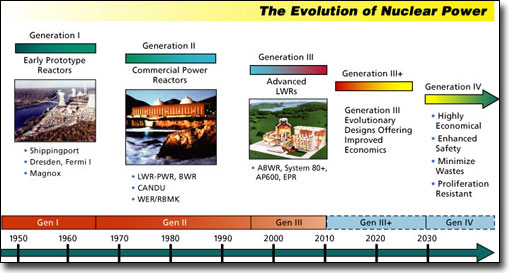The nuclear fission reaction was first discovered in 1939 by physicists Otto Hahn and Fritz Strassmann.[1] From their research Hahn and Strassmann proved that the fission reaction release large amounts of energy and the additional neutrons that were released from the reaction could sustain a chain reaction. Following the discoveries made by Hahn and Strassmann, Niels Bohr found that fission was more likely to occur in the uranium-235 isotope than in U-238.[3] Additionally, Bohr introduced the idea of a moderator by discovering that the fission reaction occurs more effectively with slow-moving neutrons than with fast neutrons. Later in 1939 Francis Perrin made the discovery of critical mass of uranium which allowed for a self-sustaining continuous release of energy.[1] Upon seeing the power of nuclear energy a great deal of resources were allocated to the research and development of nuclear bombs and nuclear power. Unfortunately, World War II began and the scientists turned their focus to the development of the atomic bomb instead of power generation.
The development of nuclear reactors can be separated into four distinct stages or generations:
- The first generation of nuclear reactors were the first to supply power for civilian use. First generation reactors are also commonly referred to as early prototypic reactors such as reactors at Shippingport in the US and Calder Hall in the UK.
- Second generation reactors were first developed in the 1960s.[2] The difference between first and second generation was the addition of control and safety features to minimize the possibility of accidents. In fact most nuclear power plants that are in operation today used second generation technology.
- It was not until the mid-1990s that the third generation of nuclear power production came into effect.[2] The third generation made use of light-water reactors that incorporated passive safety system as a means to minimize the possibility of nuclear meltdown instead of an active safety system that is used in second generation.[2] The passive safety system allows for the nuclear plant to function without operators present as well as in the event of a power failure.
- Currently a number of countries are entering the fourth generation of nuclear reactor design. Fourth generation nuclear power is based off of the research and development of revolutionary new designs.[2] One such example of next generation nuclear power plants is the concept of the pebble bed modular reactors and breeder reactors.
(Composed by Ivan Basurto, Edited by Becca McIver & Dan Kervick)
References
1. Office of Nuclear Energy, S. a. (2015, May 4). The History of Nuclear Energy . Retrieved from U.S. Department of Energy : http://www.energy.gov/sites/prod/files/The%20History%20of%20Nuclear%20Energy_0.pdf
2. Nuclear Reactor . 17 April 2015. <http://www.britannica.com/EBchecked/topic/421763/nuclear-reactor/45789/Production-reactors#toc45790>.
3. World Nuclear Association . (2015, May 4). Retrieved from Online History of Nuclear Energy : http://www.world-nuclear.org/info/current-and-future-generation/outline-history-of-nuclear-energy/
